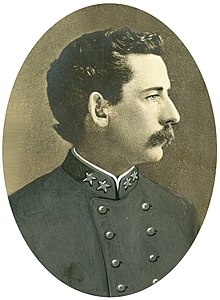R. Preston Chew
Roger Preston Chew | |
|---|---|
 | |
| Born | April 9, 1843 Loudoun County, Virginia |
| Died | March 16, 1921 (aged 77) Charles Town, West Virginia |
| Place of burial | Zion Episcopal Churchyard Charles Town, West Virginia |
| Allegiance | |
| Service | |
| Years of service | 1861–65 (CSA) |
| Rank | |
| Commands | Stuart Horse Artillery |
| Battles / wars | American Civil War |
| Other work | West Virginia Legislature 1882–1888 |
Roger Preston Chew (April 9, 1843 – March 16, 1921) was a noted horse artillery commander in the Confederate Army of Northern Virginia during the American Civil War. After the war, he was a prominent West Virginia businessman and railroad executive.
Biography
Chew was born into a prominent family in Charles Town, West Virginia (then Virginia). The Chew family owned the The Hermitage, one of the oldest houses in western Virginia.
With the outbreak of the Civil War, young Chew raised a battery of horse artillery, "Chew's Battery," which eventually became part of the famous Laurel Brigade under Stonewall Jackson's command. He participated in all Jackson's campaigns until Jackson's death in May 1863; and, despite his youth, was promoted to the chief of the cavalry's guns under J.E.B. Stuart. He served through the Gettysburg Campaign, the Wilderness, Spotsylvania Court House, Cold Harbor, the Siege of Petersburg, and the Appomattox Campaign.[1]
After the war, Chew married Louise Fontaine Washington, daughter of the last owner of Mount Vernon at Blakeley.[2] He engaged in numerous business ventures and was the president of the Eagle Manufacturing Company. In 1883, the Shenandoah Valley Railroad constructed what became known as Chew's Siding, a private spur that led from the main line to Chew's business. In 1890, with several business partners, he formed the Charles Town Mining, Manufacturing, and Improvement Company and became its first president.[3]
Chew's wife, purchased her financially struggling uncle's mansion, "Blakeley", in 1875, and maintained ownership until 1892 when she sold it.[4]
Notes
- ^ Longacre (2002)
- ^ Jean T. Crolius (January 1993), National Register of Historic Places Nomination: The Hermitage (pdf), National Park Service
- ^ Geoffrey Henry and Jared N. Tuk (April 10, 2001), National Register of Historic Places Nomination: Charles Town Mining, Manufacturing, and Improvement Company Building (pdf), National Park Service
- ^ Michael Pauley (December 7, 1981), National Register of Historic Places Nomination: Blakeley (pdf), National Park Service
References
- Longacre, Edward G., Lee's Cavalrymen: A History of the Mounted Forces of the Army of Northern Virginia, Stackpole Books, 2002, ISBN 0-8117-0898-5.
External links
- 1843 births
- 1921 deaths
- American military personnel from West Virginia
- American railroad executives
- Businesspeople from West Virginia
- Confederate States Army officers
- People from Charles Town, West Virginia
- People of West Virginia in the American Civil War
- Washington family
- Burials at Zion Episcopal Churchyard (Charles Town, West Virginia)
